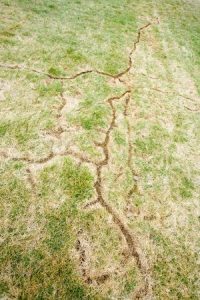
We see it every year around the middle of March. The ground begins to thaw, the snow melts, and miles of tattered, brown lawns emerge from their wintery blankets. The winter hasn’t just taken a toll on your nerves; it’s also given your lawn a serious beating. By being proactive, however, we can minimize the damage and get your lawn back on the road to recovery. The three primary enemies associated with winter lawn damage are salt, mold, and rodents. Today we’ll look at how to deal with each.

The Salt
Once the melt rolls around, you’ll likely notice that the grass adjacent to roads and sidewalks looks burned and dry. This is the result of the rock salt used to treat roads in freezing winter weather. Rock salt does a fine job of deicing roads, but it wreaks havoc on surrounding vegetation.
To repair salt-burned areas, you’ll first want to rinse residual salt from the lawn with clean water. Next, you’ll want to treat the area with a gypsum soil conditioner. The gypsum will effectively heal the damaged grass by inducing a chemical reaction that replaces residual salt with calcium and sulpher. The sooner you can apply gypsum to affected areas, the better.
The Mold
When large volumes of snow melt, all that water can oversaturate your soil and cause mold colonies to crop up, leaving gray and white patches of unhealthy grasses. With time, as the weather warms and the ground dries, most of these patches will gradually fade on their own. After especially snowy seasons, however, your lawn might need a little help. There are a number of outdoor fungicide products on the market that will eliminate snow mold and help your lawn to recover more quickly. You might also need to reseed patches of grass affected by snow mold in order to eliminate bare spots.
The Rodents
Critters such as voles and chipmunks keep themselves warm during the winter by burrowing into your lawn. Come springtime, all that rodent activity can leave your lawn pockmarked with divots and dead patches of grass. To repair this damage, you’ll first want to loosen and turn the soil with a rake or hand trowel. This will aerate the damaged areas, allowing fresh oxygen and water to permeate the soil. Next, you’ll want to prep the soil for fertilizer by watering it. Reseed and fertilize the area, then gently turn the soil again to distribute the fertilizer. Water the area regularly until healthy grass returns to the soil.
Have the know-how but not the tools? Give Lawrence Tool Rental a call today and learn how we can help.

Leave a Reply